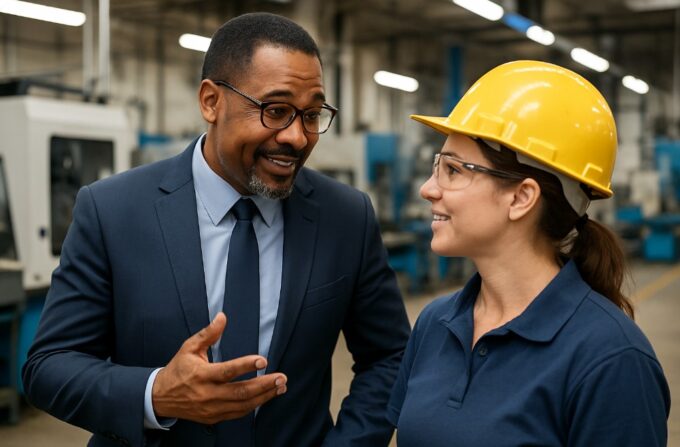A safe workplace rarely happens by accident. It grows out of steady decisions, clear expectations, and leaders who show that safety is part of daily life, not an afterthought.
When people see strong leadership habits around risk, communication, and follow-through, they relax a bit. They move with more confidence. They trust the environment around them. That shift matters more than any policy on paper.
The Tone Leaders Set Every Day

supervisor who always puts on protective gear
Leaders influence safety long before a hazard appears. Team members usually pick up on cues quickly. They watch how leaders talk about risky tasks.
They listen to the level of detail offered during briefings. They notice whether someone follows basic protocols or cuts corners.
A few examples show how much effect small habits can have.
- A supervisor who always puts on protective gear before stepping into a work zone signals that gear is non-negotiable.
- A manager who pauses a meeting to correct a minor hazard tells the room that prevention is part of the routine.
- A director who visits high-risk areas regularly shows that safety is a shared responsibility.
These actions build a workplace culture without long lectures or pressure. Leaders who invest in utbildning skyddsombud often carry that mindset into every interaction they have during a shift.
Clear Communication Reduces Guesswork

Clear Communication Reduces Guesswork
Strong communication creates a safer setting because it cuts down on assumptions. People prefer clarity when doing tasks that carry physical or mental strain.
They want to know what success looks like, what can go wrong, and who they can call if something feels off.
Practical ways leaders can support clarity
- Use concise briefings before tasks with higher risk.
- Repeat priorities during busy periods.
- Hold short end-of-shift reviews that capture what worked well and what should shift tomorrow.
- Encourage questions without turning the moment into a performance test.
The rhythm of short, honest conversations builds steadiness. When team members know what their leaders expect, they move through their workday with more confidence.
Consistency Builds Trust
Consistency is a strong safety tool. When leaders reinforce the same standards day after day, team members start to feel grounded.
They stop second-guessing which rules matter. They stop wondering whether concerns will be taken seriously.
A simple table can highlight the link between leader behavior and team response.
| Leadership Behavior | Team Response |
| Consistent safety checks | Higher compliance with basic protocols |
| Predictable follow-through on incidents | More timely reporting of hazards |
| Regular visibility on the floor | Stronger sense of support |
Patterns like these create stability. Stability creates confidence.
Employee Confidence Rises When Leadership Gets Personal

Employee Confidence Rises When Leadership Gets Personal
People feel safer when leaders show genuine interest in their daily challenges. A quick conversation about a new machine setup, or a short chat about the strain a task puts on someone’s body, can shift morale noticeably. Team members feel seen. They trust that leadership will notice hazards before they grow.
Straightforward Ways Leaders Boost Confidence
- Walk the workspace and talk to people, not just supervisors.
- Ask for input about tools, schedules, and workflow.
- Notice when someone looks fatigued and encourage a short pause.
- Celebrate routines that prevent injuries, not only big wins.
Simple contact builds a workplace that feels more stable and more human.
A Safer Workplace Starts With Visible, Steady Leadership
Strong leadership carries safety from the rulebook to the real world. When leaders act with clarity, consistency, and personal interest, confidence grows.
Work feels less chaotic. People focus better. The environment becomes safer because the tone comes from the top, reinforced every day.



